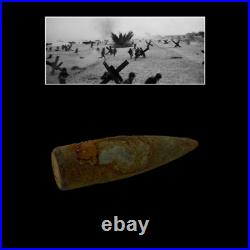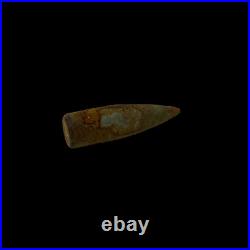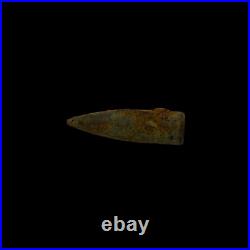RARE WWII Omaha Beach D-Day Fired Relic Recovered in 1994 (C. O. A. Included)









The Normandy landings were the landing operations and associated airborne operations on Tuesday, 6 June 1944 of the Allied invasion of Normandy in Operation Overlord during World War II. Codenamed Operation Neptune and often referred to as D-Day, it was the largest seaborne invasion in history. The operation began the liberation of France (and later western Europe) and laid the foundations of the Allied victory on the Western Front. This incredible fired relic was recovered on the Omaha Beach landing areas from Vierville sur-Mer to Port-en-Bessin which includes the landing zones of CHARLIE, DOG GREEN, DOG WHITE, DOG RED, EASY GREEN, EASY RED, FOX GREEN, & FOX RED. This was uncovered during a professional excavation of Omaha Beach in Normandy during the 50th Invasion Anniversary in 1994. Because this fired relic was excavated from the sand of Omaha Beach, it is believed that this is a German relic that was fired onto American soldiers of the 1st and the 29th Infantry Divisions exiting their LCVP (Landing Craft Vehicle & Personal Higgins).
On the morning of June 6, 1944, two U. Infantry divisions, the 1st and the 29th, landed at Omaha Beach, the second to the west of the five landing beaches of D-Day. Opposing the landings was the German 352nd Infantry Division. Of its 12,020 men, 6,800 were experienced combat troops, detailed to defend a 53-kilometer (33 mi) front. The German strategy was based on defeating any seaborne assault at the water line, and the defenses were mainly deployed in strongpoints along the coast.
Casualties on Omaha Beach were the worst of any of the invasion beaches on D-Day, with 2,400 casualties suffered by U. And that includes wounded and killed as well as missing. There is no concrete number for the German forces that were killed at Omaha Beach. Those records simply did not exist, and entire German units were wiped out virtually to a man. Any best estimate at the German losses on D-Day is a guess. Lead Allied assault forces 1st US Infantry Division, troops from 29th US Infantry Division, US Rangers. German Defenders Troops from 352nd Infantry Division and 716th Infantry Division.Objectives US forces aim to advance inland and gain control of the main east-west road. Hourly Timeline of D-Day Landing on Omaha Beach. Bomber aircraft of RAF Bomber Command attack a range of targets in the whole landing area. The first waves of landing craft head for the beach.
USS Nevada bombarding a German gun battery in Normandy with her 14 inch guns. (Photo: Conseil Régional de Basse-Normandie / US National Archives). Allied warships begin bombarding German defenses in the Omaha area.
Some German gun batteries try to fire back but are temporarily silenced. Despite the rough seas, most of the 64 DD (amphibious) tanks begin to launch into the water around 5,000 yards out. Many sink as they approach the beaches, meaning that the infantry will have fewer tanks to support them as they land.Nearly 450 American heavy bomber aircraft drop bombs, but they fall too far inland (5km) rather than in the beach area. Due to low cloud, the aircraft add a brief delay to dropping their bombs, to ensure they do not hit any friendly forces. Support landing craft begin to fire guns and rockets against German defences along the beach.
US infantry begins landing on Omaha Beach. They have to cross around 300 yards of beach before they can find a little cover in the form of a shingle bank and sea wall. Many are killed by the fire of German defenders, or lose their weapons and equipment in the confusion. Enemy fire and a higher than expected tide make it difficult for the Americans to clear away beach obstacles, which are increasingly covered by the tide. Many of the larger landing craft have to wait offshore rather than landing their troops because they cannot get through the obstacles.
2nd US Rangers arrive at Pointe du Hoc, and begin climbing the cliffs so they can attack the coastal gun battery on top. 2nd US Rangers have scaled the cliff. They find that the coastal guns have been removed, but later find them inland and destroy them. US troops are still struggling to gain a foothold in the main beach landings. Eleven destroyers come closer inshore to fire their guns directly at German strongpoints to aid the troops.
Gradually small groups of US infantry begin to advance off the beach, where there are weaker spots in the German defences. US troops start to get to the top of the bluffs (hills at the back of the beach).
However many are still disorganised. Surviving German troops in the beach defences start to surrender (though some hold out until late afternoon). The road inland at St Laurent is clear, so that vehicles can move up it and support the infantry. During the afternoon, engineers have managed to clear more routes through the beach obstacles and more routes off the beaches that vehicles can use. US troops capture several villages just behind the beach.Omaha Beach: At the end of D-Day: Due to the difficulties experienced by US troops at the start of the landings, the Americans have only advanced about one mile inland in most places. The beachhead is not yet secure and is still shelled by German artillery.
However German forces here are also off balance, and not yet able to make a strong counter-attack. At Pointe du Hoc, 2nd US Rangers have destroyed the long range coastal guns and held out against strong counter-attacks, losing 90 out of the 225 men who had originally landed. Troops from the main beach landings have not yet linked up with them.
Casualties at Omaha Beach on D-Day: Total casualty figures for D-Day were not recorded at the time and are difficult to confirm in full. The US Army has lost 3,686 casualties including around 777 killed. Other Allied losses include 539 naval and 10 air forces casualties.The German have lost over 1,000 casualties. General Summary of D-Day Operations on Omaha Beach. Omaha Beach linked the U.
It was a critical link between the Cotentin Peninsula, also known as the Cherbourg Peninsula, and the flat plain in front of Caen. Omaha was also the most restricted and heavily defended beach. For that reason, at least one veteran U.
Division (lst Infantry Division) was tasked to land there. Omaha beach was unlike any of the other assault beaches in Normandy. Its crescent curve and unusual assortment of bluffs, cliffs and draws were immediately recognizable from the sea. It was the most defensible beach chosen for D-Day; in fact, many planners did not believe it a likely place for a major landing.
The high ground commanded all approaches to the beach from the sea and tidal flats. Moreover, any advance made by U.
Troops from the beach would be limited to narrow passages between the bluffs. Advances directly up the steep bluffs were difficult in the extreme.
German strongpoints were arranged to command all the approaches and pillboxes were cited in the draws to fire east and west, thereby enfilading troops while remaining concealed from bombarding warships. These pillboxes had to be taken out by direct assault. Compounding this problem was the allied intelligence failure to identify a nearly full-strength infantry division, the 352nd, directly behind the beach.
It was believed to be no further forward than St. Lo and Caumont, 20 miles inland. The V Corps was assigned to this sector.The objective was to obtain a lodgment area between Port-en-Bessin and the Vire River and ultimately push forward to St. Lo and Caumont in order to cut German communications St. Lo was a major road junction.
Allocated to the task were 1st and 29th Divisions, supported by the 5th Ranger Battalion and 5th Engineer Special Brigade. This item is in the category "Collectibles\Militaria\WW II (1939-45)\Original Period Items\United States\Field Gear, Equipment". The seller is "premierrelics" and is located in this country: US.
This item can be shipped worldwide.
- Theme: Militaria
- Original/Reproduction: Original
- Conflict: WW II (1939-45)
